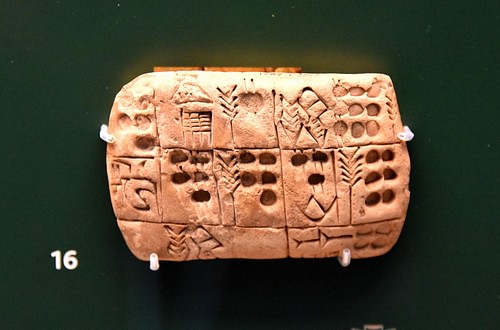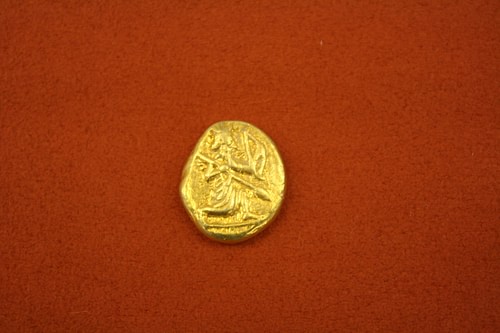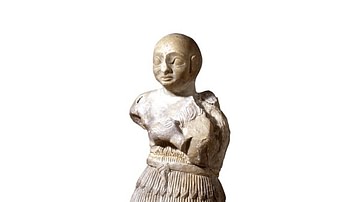Local trade in ancient Mesopotamia began in the Ubaid Period (c. 5000-4100 BCE), had developed into long-distance trade by the Uruk Period (c. 4100-2900 BCE), and was flourishing by the time of the Early Dynastic Period (2900-2334 BCE). Developments in trade continued up through 651 CE, the beginning of the modern period of the Near East.

Trade began in Mesopotamia for the same reason it did anywhere else – need. The Mesopotamians had a surplus of grain, clay, and reeds (among other assets) they could offer in return for resources they lacked such as precious metals, minerals, and wood from other regions.
Goods exported in long-distance trade included:
- ceramics
- glass
- grain
- leather products
- fish, palm, and vegetable oil
- reed baskets and mats
- textiles
Goods imported from outside Mesopotamia included:
- copper, ivory, pearls, semi-precious stones, carnelian beads (Indus Valley Civilization)
- gold, silver, other precious metals (Egypt and Asia Minor)
- wood (Levant and Elam – later Persia)
- lapis lazuli (ancient Afghanistan)
The development of long-distance trade during the Ubaid and Uruk periods led to the invention of writing in the form of cuneiform script by c. 3500 BCE so that merchants could communicate with clients in foreign regions or distant Mesopotamian cities. Cuneiform was refined at Uruk c. 3200 BCE, enabling clearer and more precise communication in written form which, eventually, allowed for the development of literature. Trade also encouraged the application of the wheel to vehicles for transport, the development of roads, and the further cultivation of domesticated animals to pull the carts and carry the merchants.
The Agricultural Revolution (c. 10,000 BCE), domesticating plants and animals, is understood as the foundation of civilization, but local and long-distance trade encouraged its development. The five aspects that define civilization – surplus food, a division of labor, urbanization, government, and a writing system – all developed or were further encouraged by trade.
Early Trade
Local trade began between the Mesopotamian communities of the Ubaid Period and would have been conducted by merchants traveling on foot or, perhaps, using pack animals. Trade goods which have been positively identified are ceramics, including bowls, jugs, and figurines (the famous "lizard people" among them). The cylinder seal, which identified the artist or merchant, site of manufacture, or value had already been developed by this time when it began to be used with greater frequency.
Although the Ubaid Period is most often associated with local trade, some scholars suggest long-distance trade at this time with regions as far away as China. It also seems clear that the Ubaid communities of Northern Mesopotamia traded as far south as Dilmun (modern Bahrain) and Magan (modern UAE and Oman) in the Persian Gulf, a vital center of trade linking the Near East with regions further east including the Indus Valley Civilization. The city of Eridu was a central participant in trade before c. 5000 BCE and would have been involved in this exchange, which would also include the cities of Uruk, Ur, and Nippur during the Uruk Period.
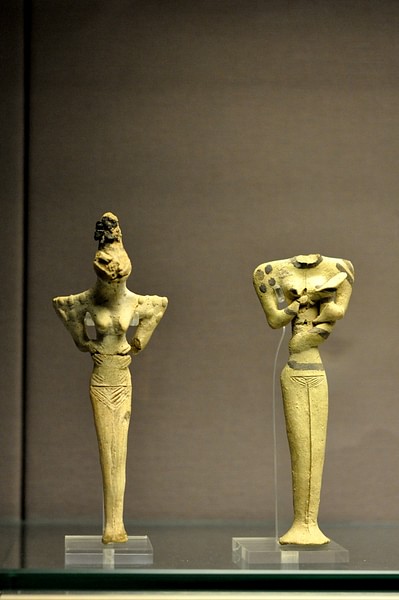
Uruk Period & Trade
The Uruk Period saw the establishment of trade with Egypt during that region's Gerzean Period (also known as Naqada II Period (c. 3500-3200 BCE). Mesopotamian ceramics from Sumer – which would have come from cities including Eridu, Nippur, Ur, and Uruk – dated to c. 3500 BCE have been excavated in Egypt and include ceramics, cylinder seals, and lapis lazuli pendants. Evidence for the wealth generated by the Sumerian cities through trade is suggested by their expansion during this period, especially Uruk, which established several settlements beyond its initial boundaries at important junctions on trade routes.
Overland trade throughout Mesopotamia was ongoing during this period along the established routes and down the Tigris and Euphrates rivers to the Persian Gulf. The island of Bahrain, identified by the Sumerians as Dilmun, the Land of the Gods, served as a central trade depot for goods coming from the Indus Valley Civilization (7000-600 BCE). No monetary system in the form of coinage existed at this point; goods were exchanged for others considered of equal value. Scholars M. Wayne Alexander and William Violet comment:
Money in the form of standardized coins had yet to be minted by governments. However, silver and grain had been continuously in use as mediums of exchange during the fourth to second millenniums. (14)
The practice of exchanging goods of equal value was most common, however, as Alexander and Violet note concerning the textiles from the city of Ur during this period:
Records indicate that around six thousand women worked at nearby Girsu and thirteen thousand worked in and around Ur weaving woolen textiles…Textiles produced in the temple's workshops were exported to distant lands in exchange for metals, precious stones…barley, and other natural resources. (14)
Among the regions the Ur textiles went was the Levant, where Sumerian goods were traded with the cities of ancient Lebanon by 3000 BCE, and by that same date, the city of Byblos in the Levant was exchanging these goods with Egypt along with their highly-valued wood and papyrus. Wood was also imported from the region of Elam at this time in exchange for ceramics. Mesopotamian trade was already established with Elam by the Proto-Elamite Period (c. 3200 to c. 2700 BCE) and influenced the development of Elamite art, architecture, and culture throughout the Old Elamite Period (c. 2700 to c. 1600 BCE).
According to some scholars, Mesopotamian – specifically Sumerian – trade also influenced the art and architecture of Egypt. Scholar Margaret Bunson, to cite only one example, notes how the famous Narmer Palette (c. 3150 BCE) "with its depiction of monsters and entwined long-necked serpents is distinctively Mesopotamian in design" (267). A lump of blue glass found at Eridu in 1919 CE, positively identified as coming from a nearby ancient glass factory, and dated to 2000 BCE, matches similar blue glass pieces found in Egypt and suggests that Egyptian glassmaking was introduced through trade with Mesopotamia. Egyptian statuettes and architectural designs from this period also suggest a Mesopotamian influence, which would continue through the Early Dynastic Period.
Early Dynastic & Akkadian Periods
During the Uruk Period, trade flourished, and the ziggurat – the distinctive Mesopotamian monumental architecture – developed. The ziggurat not only served a religious function but also a practical one in distinguishing a certain city from a distance and acting as a landmark. Uruk continued to dominate trade in Mesopotamia during this era, but then, as scholar Paul Kriwaczek notes, something happened:
Archaeology tells us of momentous changes around 3000 BCE. Suddenly, or so it seems, contact between the many centers of civilization distributed all over greater Mesopotamia ceased. Trade routes, like those to the Afghan lapis-lazuli mines, were cut. Uruk outposts disappeared from across the region: from Iran, Syria, Anatolia. (72)
Kriwaczek cites possible reasons for this, including climate change, but maintains the primary cause was the aggression and overreach of Uruk, which was finally met with resistance from the other city-states. By the time of the Early Dynastic Period, roughly, this situation had been resolved (how is unclear), and the cities of Mesopotamia involved in long-distance trade included but were not limited to:
- Adab (with Egypt up to 2000 BCE)
- Akshak (with Afghanistan and probably Egypt)
- Ebla (with Egypt and others)
- Eridu (with Egypt and others)
- Kadesh (with Egypt)
- Kish (with Elam)
- Larsa (with Indus Valley Civilization up until c. 2358 when it was destroyed)
- Mari (with Egypt for gold, with Levant, and others)
- Nippur (unclear)
- Shuruppak (with Egypt – grain for gold – and with others)
- Sippar (unclear)
- Tell Brak (with Egypt and others)
- Umma (possibly with Egypt under its king Lugal-zage-si, r. c. 2358-2334 BCE)
- Ur (with Egypt and others)
- Uruk (with Egypt and others)
By the time of the Early Dynastic III period (2600-2334 BCE), Kish and Uruk were the dominant political and commercial powers. Each city-state was an autonomous political entity and, naturally, vied with each other in trade and for resources such as land and water rights. This all changed with the rise of Sargon of Akkad (the Great, r. 2334-2279 BCE) who conquered the region and established the Akkadian Empire.
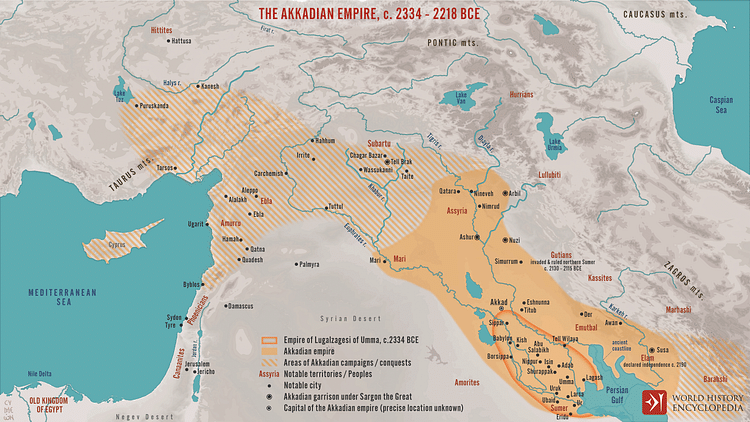
During the Akkadian Period (2334-2218 BCE), the city-states were all under the control of the city of Akkad (also given as Agade) and trade was regulated by Akkadian officials elevated to positions of authority in the various cities. Local and long-distance trade flourished under Akkadian bureaucracy, which eliminated the rivalry between city-states and standardized prices and practices while also improving roads. Kriwaczek describes the results of the Akkadian policies:
Ships from as far afield as Bahrain (in Akkadian, Dilmun), Oman (Magan), and even the Indus (Meluhha) docked at Akkad's quaysides and unloaded their treasures; foreign mariners speaking in strange accents thronged the streets near the harbors. Barges laden to the gunwales with grain from distant rain-watered farms far beyond the alluvial plain daily arrived in the harbor, unshipped their cargoes, and were promptly dismantled, the wood destined for recycling in expansive local building projects. (125)
At the same time the region was experiencing this economic boom through trade, however, it was periodically rocked by social unrest as the city-states rebelled against Akkadian rule. Sargon and his successors put down revolts throughout the region continually until Akkad finally fell and the Gutians, a West Asiatic people of the Zagros Mountains. Kriwaczek (as well as others) has noted that Akkad most likely fell for many reasons, including climate change, and the Gutians were then blamed by Sumerian scribes who resented their control of the region.
Gutian & Ur III Periods
The Gutian Period (2218-2047 BCE) shows a marked decline in trade, which, according to the scribes of the later Ur III Period (2047-1750 BCE), was entirely the fault of the Gutians. According to these later accounts, both overland and maritime trade stalled, and robbers roamed the highways and stalked the trade routes. Archaeological evidence supports the drop in trade and economic decline during this period, and it is possible, even likely, the Gutians mismanaged affairs, but the probable cause was drought, bringing famine, and eliminating the surplus grain that was the staple of Mesopotamian trade.
The Sumerians were led in revolt against Gutian rule by Utu-Hegal, King of Uruk (r. c. 2055-2047 BCE) and, after his death, by Ur-Nammu (r. 2047-2030 BCE), founder of the Third Dynasty of Ur, who further broke the Gutian hold on the land and re-established trade. Archaeological evidence supports the Sumerian scribes' description of Ur-Nammu's reign as prosperous as evidenced by the Great Ziggurat of Ur begun under his reign, his law code (the Code of Ur-Nammu), as well as improvements to the infrastructure and the rebuilding or renovation of cities like Lagash and various temples. When the Gutians rose again in 2030 BCE, Ur-Nammu was killed in battle and his son Shulgi of Ur (r. 2029-1982 BCE) assumed the throne.
Trade again flourished under Shulgi, who, after driving out the Gutians, conquered the region corresponding to modern-day Kuwait up through Iraq and then standardized weights and measures, timekeeping, and the calendar so that his entire kingdom would operate in unison. The major Mesopotamian city-states under Shulgi's reign all seem to have engaged in long-distance trade which encouraged prosperity, economic stability, and the rebirth of the region's culture known as the Sumerian Renaissance.
The government – whether of the individual city-states during the Uruk through Early Dynastic periods or a central authority during the Akkadian and Ur III periods – was responsible for regulating and supervising local and long-distance trade as well as building and maintaining warehouses, docks, and roads. Shulgi instituted roadside inns for travelers, which were ornamented by gardens. Mesopotamian commercial success was mirrored by their long-distance partners in trade and, as essential needs were met, luxury items became a premium commodity. Scholar Gwendolyn Leick comments:
As the countries around Mesopotamia also developed their own stratified states and affluent elites, demand grew for luxury items produced in Mesopotamia. These were textile goods (woolen cloth, finished garments, embroidered robes), leatherwear, wooden and inlaid furniture, bronze weapons, highly crafted metal, and stone artifacts and jewelry. Such products were exported all over the Near East, including Egypt, during the second millennium and then again during the Neo-Babylonian period. (174)
After Shulgi's death, his successors tried to maintain the cohesion of the kingdom, but it steadily unraveled as nomadic Amorites established permanent settlements and challenged Ur's authority. Ur finally fell to the Elamites in 1750 BCE, but the Amorites had, by this time, firmly established themselves in the region and would be the next people to oversee and encourage Mesopotamian trade.
Hammurabi & Club of Great Powers
The Amorite king Hammurabi (r. 1792-1750 BCE) began his reign in Babylon quietly building and training an army and then swiftly conquered the entire region. After establishing his authority, he set about improving the infrastructure earning him the title bani matim ("Builder of the Land") for his construction and improvement of roads, inns, warehouses, and other building projects. Scholar Lionel Casson writes:
In a letter to an official at Larsa, [Hammurabi] orders certain personnel to be sent to him as fast as possible, specifying that they are to "travel day and night and so get to Babylon within two days." The two cities are about 120 miles [193 km] apart; if we allow from thirty-six to forty-eight hours, it means he was counting on an average speed of 2 &1/2 to 3 & ½ miles per hour, and this is almost as good as travelers in mule-drawn carts did on the highly touted Roman roads two millennia later. (26)
Casson further notes that paving was almost non-existent, and, except for later roadwork by the Hittites, merchants, travelers, and armies would have moved along dirt roads, and since bridges were scarce, they would have to either use ferries to cross waterways (which involved dismantling vehicles such as carts to make them fit), hire boats, or find a way around them. Bands of thieves were another difficulty merchants had to consider, and many would hire armed guards, sometimes a substantial number, to protect their interests.
Hammurabi's kingdom, like Shulgi's, fell apart shortly after his death and was then taken by the Hittites in 1595 BCE before control was assumed by the Kassite Dynasty (c. 1595 to c. 1155 BCE) who again maintained trade, but it is unclear to what extent. By 1500 BCE, the Assyrians had asserted themselves as a major power, and by 1400 BCE, they had won their independence from the Kingdom of Mitanni. The economic and military strength of the largest of the individual states of the Near East, and their neighbors, encouraged equality and cooperation.
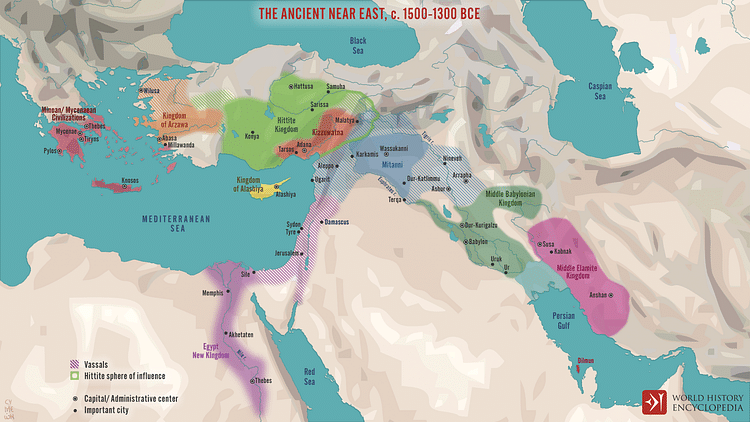
Between 1500-1200 BCE, the so-called Club of the Great Powers supervised and regulated international trade. This included:
Scholar Marc van de Mieroop writes:
During the centuries from 1500-1200, the Near East became fully integrated in an international system that involved the entire region from western Iran to the Aegean Sea, from Anatolia to Nubia. A number of large territorial states interacted with one another as equals and rivals. Located between them, especially in the Syro-Palestinian area, was a set of smaller states that owed allegiance to their more powerful neighbors, and which were often used as proxies in their competition. (129)
By the time of the Amarna Letters (correspondence between members of the 'club' and Egypt during the Amarna Period of c. 1348-1320 BCE), the Club of Great Powers included:
- Assyria
- Alashiya (on Cyprus)
- Arzawa (south-west Anatolia)
- Babylonia
- Egypt
- Hatti (Kingdom of the Hittites)
- Mitanni
Trade continued among these powers (and others, even as far north as Denmark) with periodic upsets and military clashes until the Bronze Age Collapse (c. 1250 to c. 1150 BCE) when climate change, natural catastrophes, social unrest, political instability, and invasions by the Sea Peoples toppled civilizations and disrupted trade as well as the social order throughout the Mediterranean and Near East.
Conclusion
By 525 BCE, all of the states of the Club of Great Powers were gone. Hatti and Mitanni were gone by 1200 BCE, the Assyrian Empire fell in 612 BCE, and Babylonia, Arzawa, and Alashiya had been taken by the Persian Achaemenid Empire (c. 550-330 BCE). Egypt fell to the Persians in 525 BCE, and it was only at this time that coinage was introduced into Egyptian trade practices. Coins were first minted in Lydia under the reign of King Alyattes (c. 635-585 BCE) of Sardis, but trade in the Near East had continued to use the barter system. Cyrus II (the Great, r. c. 550-530 BCE) introduced coins in trade after his conquest of Lydia, and Darius I (the Great, r. 522-486 BCE) is thought to have developed the daric, the first gold coin with a standardized value, which would then be used in trade throughout the Achaemenid Empire.
This practice was continued after the empire fell to Alexander the Great in 330 BCE and was maintained by political entities that followed: the Seleucid Empire (312-63 BCE), the Parthian Empire (247 BCE to 224 CE), and the Sassanian Empire (224-651 CE), all of whom regulated trade as an integral aspect of government. After the Sassanian Empire fell to the Muslim Arabs in 651 CE, and the new rulers instituted their own policies regarding trade, they were essentially only following patterns set down thousands of years earlier.
Grateful acknowledgment to Ms. Marjorie Hilton for the inspiration in writing this piece.
